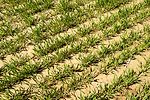Articles Tagged with ''cover crops''
[Podcast] Making Cover Crops Work in Semi-Arid Environments
Although most growers this year have been dealing with too much rain, there are areas and years when getting a cover crop established and reaping the benefit without draining soil moisture is a challenge.
Read More
[Podcast] Understanding Carbon-to-Nitrogen Ratios & Cover Crops
The carbon-to-nitrogen ratio is a critical number to know when planning for both cover crops and cash crops, according to Pennsylvania cover crop expert Steve Groff. The C:N ratio affects decomposition rates for crop residues and impacts nitrogen cycling as well. (Courtesy of Cover Crop Innovators)
Read More





